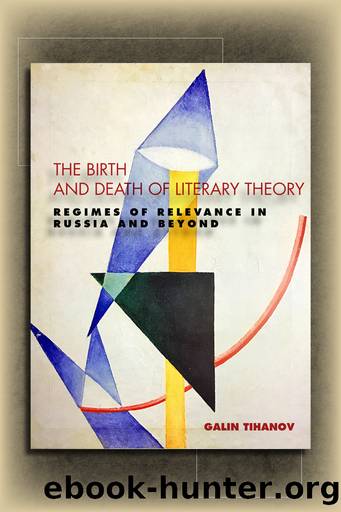The Birth and Death of Literary Theory by Tihanov Galin;

Author:Tihanov, Galin; [Tihanov, Galin]
Language: eng
Format: epub
Publisher: Stanford University Press
Published: 2019-07-14T16:00:00+00:00
4
THE BOUNDARIES OF MODERNITY
Semantic Paleontology and Its Subterranean Impact
Some of the features of Bakhtin’s methodology and style of theorizing discussed in the previous chapter—especially his predilection for a history of literature and culture “without names,” his preoccupation with genre and memory of genre, as well as his reevaluation of the significance of folklore and communitarian culture and their place on the discursive map of modernity—were shared by other methodological formations in the 1930s, most notably by the adherents of “semantic paleontology.” Itself a relatively small group of academics, brought together by admiration for Nikolai Marr’s “new doctrine of language” and his methodology of cultural analysis, this formation in turn had a considerable impact, as we shall see in the last section of this chapter, on Bakhtin and some of his contemporaries. When it comes to the specific ways in which they understood the relevance of literature, the practitioners of semantic paleontology worked within a framework that, in retrospect, must be recognized as akin to Bakhtin’s wider philosophy of culture; they also positioned themselves proactively vis-à-vis Russian Formalism, seeking to radicalize some of its impulses, while rejecting others.
The presence of semantic paleontology in literary studies and its importance for the methodological debates of the 1930s have never before been examined systematically. I thus begin by outlining the foundations of semantic paleontology and its interventions in the study of literature during the 1930s; as a next step, the analysis focuses on the principal methodological distinctions that semantic paleontology sought to draw in order to assert its own identity vis-à-vis other trends. Attention then turns to the central question: what was the place of semantic paleontology in the 1930s polemics on how and where one should draw the boundaries of modernity, and how did this shape the way its practitioners assigned significance to literature? In the final sections I weigh the impact of semantic paleontology on cultural and literary theory. As will become evident, this impact did not follow the channels of official recognition, yet it persisted into the early 1980s, at times paradoxically reinforced by the critique that semantic paleontology triggered.
Foundations and Early Work: The Manifesto Volume on Tristan and Isolde
After decades of neglect, semantic paleontology is now finally enjoying a moment of renewed interest in the West, which goes hand in hand with fresh explorations in the field of historical poetics.1 The exponents of semantic paleontology came of age as scholars and thinkers in the course of the 1920s and produced their most significant work in the 1930s; by that time Nikolai Marr had reached the apogee of his public influence (in 1930, he was accorded the honor of addressing the Sixteenth Congress of the All-Union Communist Party (Bolsheviks) and soon afterward joined the Party as its only member among the academicians elected to the Academy of Sciences before 1917).2
Unlike “bourgeois,” purely “formal” linguistics (the vast body of primarily historical and comparative research that Marr brushed aside as sterile “Indo-Europeanistics”), the “new doctrine of language,” as Marr’s own teaching came to
Download
This site does not store any files on its server. We only index and link to content provided by other sites. Please contact the content providers to delete copyright contents if any and email us, we'll remove relevant links or contents immediately.
| African | Asian |
| Australian & Oceanian | Canadian |
| Caribbean & Latin American | European |
| Jewish | Middle Eastern |
| Russian | United States |
4 3 2 1: A Novel by Paul Auster(11768)
The handmaid's tale by Margaret Atwood(7429)
Giovanni's Room by James Baldwin(6789)
Asking the Right Questions: A Guide to Critical Thinking by M. Neil Browne & Stuart M. Keeley(5340)
Big Magic: Creative Living Beyond Fear by Elizabeth Gilbert(5332)
Ego Is the Enemy by Ryan Holiday(4927)
On Writing A Memoir of the Craft by Stephen King(4651)
The Body: A Guide for Occupants by Bill Bryson(4565)
Ken Follett - World without end by Ken Follett(4431)
Bluets by Maggie Nelson(4245)
Adulting by Kelly Williams Brown(4218)
Eat That Frog! by Brian Tracy(4141)
Guilty Pleasures by Laurell K Hamilton(4105)
White Noise - A Novel by Don DeLillo(3821)
The Poetry of Pablo Neruda by Pablo Neruda(3804)
Fingerprints of the Gods by Graham Hancock(3727)
Alive: The Story of the Andes Survivors by Piers Paul Read(3718)
The Book of Joy by Dalai Lama(3678)
The Bookshop by Penelope Fitzgerald(3610)
